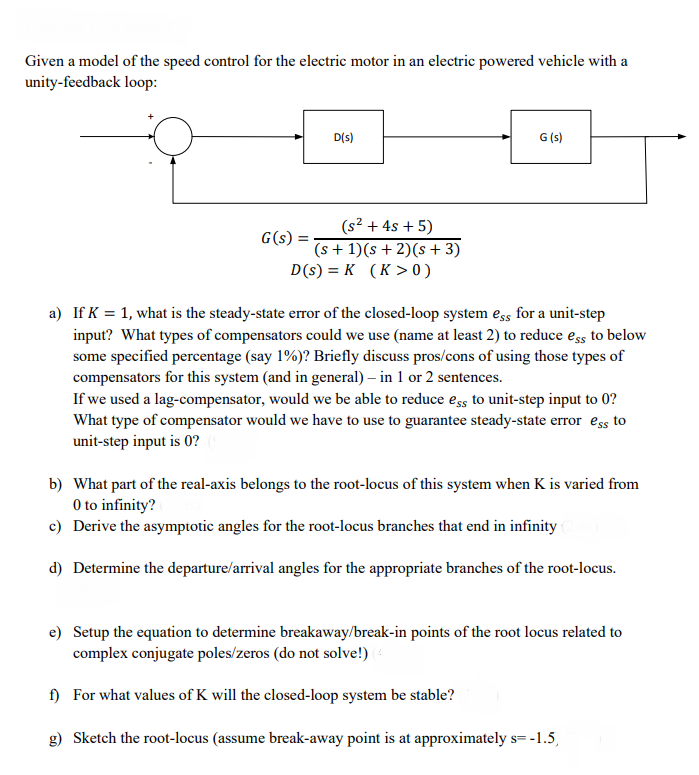Given a model of the speed control for the electric motor in an electric powered vehicle with a unity-feedback loop: D(s) G (s) (s² + 4s + 5) G(s) : (s + 1)(s +2)(s+3) D(s) = K (K>0 ) a) If K = 1, what is the steady-state error of the closed-loop system ess for a unit-step input? What types of compensators could we use (name at least 2) to reduce eșs to below some specified percentage (say 1%)? Briefly discuss pros/cons of using those types of compensators for this system (and in general) – in 1 or 2 sentences. If we used a lag-compensator, would we be able to reduce ess to unit-step input to 0? What type of compensator would we have to use to guarantee steady-state error ess to unit-step input is 0? b) What part of the real-axis belongs to the root-locus of this system when K is varied from O to infinity? c) Derive the asymptotic angles for the root-locus branches that end in infinity
Given a model of the speed control for the electric motor in an electric powered vehicle with a unity-feedback loop: D(s) G (s) (s² + 4s + 5) G(s) : (s + 1)(s +2)(s+3) D(s) = K (K>0 ) a) If K = 1, what is the steady-state error of the closed-loop system ess for a unit-step input? What types of compensators could we use (name at least 2) to reduce eșs to below some specified percentage (say 1%)? Briefly discuss pros/cons of using those types of compensators for this system (and in general) – in 1 or 2 sentences. If we used a lag-compensator, would we be able to reduce ess to unit-step input to 0? What type of compensator would we have to use to guarantee steady-state error ess to unit-step input is 0? b) What part of the real-axis belongs to the root-locus of this system when K is varied from O to infinity? c) Derive the asymptotic angles for the root-locus branches that end in infinity
Introductory Circuit Analysis (13th Edition)
13th Edition
ISBN:9780133923605
Author:Robert L. Boylestad
Publisher:Robert L. Boylestad
Chapter1: Introduction
Section: Chapter Questions
Problem 1P: Visit your local library (at school or home) and describe the extent to which it provides literature...
Related questions
Question
Problem 1e) should say (ignore the part about complex-conjugate poles/zeros ) :
Setup the equation to determine breakaway/break-in points of the root locus

Transcribed Image Text:Given a model of the speed control for the electric motor in an electric powered vehicle with a
unity-feedback loop:
D(s)
G (s)
(s² + 4s + 5)
G(s)
(s + 1)(s +2)(s + 3)
D(s) = K (K >0)
a) If K = 1, what is the steady-state error of the closed-loop system ess for a unit-step
input? What types of compensators could we use (name at least 2) to reduce ess to below
some specified percentage (say 1%)? Briefly discuss pros/cons of using those types of
compensators for this system (and in general) – in 1 or 2 sentences.
If we used a lag-compensator, would we be able to reduce ess to unit-step input to 0?
What type of compensator would we have to use to guarantee steady-state error ess to
unit-step input is 0?
b) What part of the real-axis belongs to the root-locus of this system when K is varied from
O to infinity?
c) Derive the asymptotic angles for the root-locus branches that end in infinity
d) Determine the departure/arrival angles for the appropriate branches of the root-locus.
e) Setup the equation to determine breakaway/break-in points of the root locus related to
complex conjugate poles/zeros (do not solve!)
f) For what values of K will the closed-loop system be stable?
g) Sketch the root-locus (assume break-away point is at approximately s= -1.5,
Expert Solution
This question has been solved!
Explore an expertly crafted, step-by-step solution for a thorough understanding of key concepts.
Step by step
Solved in 4 steps with 4 images

Knowledge Booster
Learn more about
Need a deep-dive on the concept behind this application? Look no further. Learn more about this topic, electrical-engineering and related others by exploring similar questions and additional content below.Recommended textbooks for you

Introductory Circuit Analysis (13th Edition)
Electrical Engineering
ISBN:
9780133923605
Author:
Robert L. Boylestad
Publisher:
PEARSON

Delmar's Standard Textbook Of Electricity
Electrical Engineering
ISBN:
9781337900348
Author:
Stephen L. Herman
Publisher:
Cengage Learning

Programmable Logic Controllers
Electrical Engineering
ISBN:
9780073373843
Author:
Frank D. Petruzella
Publisher:
McGraw-Hill Education

Introductory Circuit Analysis (13th Edition)
Electrical Engineering
ISBN:
9780133923605
Author:
Robert L. Boylestad
Publisher:
PEARSON

Delmar's Standard Textbook Of Electricity
Electrical Engineering
ISBN:
9781337900348
Author:
Stephen L. Herman
Publisher:
Cengage Learning

Programmable Logic Controllers
Electrical Engineering
ISBN:
9780073373843
Author:
Frank D. Petruzella
Publisher:
McGraw-Hill Education

Fundamentals of Electric Circuits
Electrical Engineering
ISBN:
9780078028229
Author:
Charles K Alexander, Matthew Sadiku
Publisher:
McGraw-Hill Education

Electric Circuits. (11th Edition)
Electrical Engineering
ISBN:
9780134746968
Author:
James W. Nilsson, Susan Riedel
Publisher:
PEARSON

Engineering Electromagnetics
Electrical Engineering
ISBN:
9780078028151
Author:
Hayt, William H. (william Hart), Jr, BUCK, John A.
Publisher:
Mcgraw-hill Education,